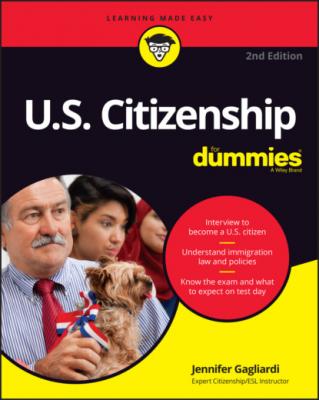U.S. Citizenship For Dummies. Jennifer Gagliardi
Чтение книги онлайн.
Читать онлайн книгу U.S. Citizenship For Dummies - Jennifer Gagliardi страница 22
 you want to change the purpose of your visit while you’re in the United States, then you, or in some cases your employer, must ask the USCIS to change your nonimmigrant status. Not all requests will be honored. For instance, if you’re a tourist who wants to become a student in the U.S., you should state that you’re looking into schools when you first enter the United States on a tourist visa. Otherwise, you’ll need to first leave the country before being able to obtain a student visa.
you want to change the purpose of your visit while you’re in the United States, then you, or in some cases your employer, must ask the USCIS to change your nonimmigrant status. Not all requests will be honored. For instance, if you’re a tourist who wants to become a student in the U.S., you should state that you’re looking into schools when you first enter the United States on a tourist visa. Otherwise, you’ll need to first leave the country before being able to obtain a student visa.
If you were admitted to the United States in one of the following visa categories, you may not apply to change your nonimmigrant status (you will first need to leave the country in order to change your immigration status):
C (Alien in Transit)
D (Crewman)
K-1 or K-2 (Fiancé[e] or Dependent of Fiancé[e])
K-3 or K-4 Certain Husbands and Wives of U.S. Citizens and their Dependent Children
S (Witness or Informant)
TWOV (Transit without Visa)
WT or WB (Under the Visa Waiver Program)
If you were admitted in any of the following nonimmigrant categories, there are certain restrictions concerning your ability to request a change in your nonimmigrant status:
J-1: An exchange visitor subject to the two-year foreign residence requirement cannot change status, with certain exceptions.
M-1: A vocational student cannot change status to F-1. (Also, a vocational student cannot change status to any H classification even if the vocational training helped the student qualify for the H classification.)
www.uscis.gov/sites/default/files/document/guides/C2en.pdf
There’s one exception to the rule that limits nonimmigrant visa holders to the activity stated on their visas: Business travelers may stay for pleasure after their business is over — providing they leave the country within the time period designated on their I-94 cards. Everyone else who wants to change the nature of their visit from the purpose stated on their visa must submit an application to change status to the USCIS. Failing to do so constitutes breaking U.S. immigration law, which in turn damages your chances of getting future temporary or permanent visas.
Adjusting status from nonimmigrant to immigrant
Providing that a visa number is available through the Department of State (unless you’re in a category that is exempt from numerical limitations — you can find more on this later in this chapter), certain nonimmigrants may adjust their immigration status from nonimmigrant to immigrant. Immediate relatives of U.S. citizens usually are exempt from waiting for visa numbers and can adjust their status quickly.
If you have to wait for an immigrant visa number and are outside the United States when it becomes available, you’ll be notified to go to the local U.S. consulate to complete the processing. This visa process is known as consular processing.
Gaining Permanent Resident Status (or a Green Card)
As we discuss in Chapter 1, most people gain lawful permanent residence through a family connection or through employment. In the following sections, we explore these categories in more detail, as well as other ways people can legally live and work in the United States on a permanent basis.
Understanding the family preference categories
Family-based immigrant visa numbers are distributed according to preference categories. The higher you rank on the preference scale, the sooner you’re likely to receive a number. The following are the four family-preference categories:
First preference (F1): Unmarried sons and daughters (21 years of age and older) of U.S. citizens
Second preference (F2A): Spouses and children (unmarried and under 21 years of age) of lawful permanent residents
Second preference (F2B): Unmarried sons and daughters (21 years of age and older) of lawful permanent residents
Third preference (F3): Married sons and daughters of U.S. citizens
Fourth preference (F4): Brothers and sisters of U.S. citizens (if the U.S. citizen is 21 years of age or older)
See USCIS Green Card for Family Preference Immigrants at www.uscis.gov/green-card/green-card-eligibility/green-card-for-family-preference-immigrants.
Marrying your way to permanent residence
Although it’s usually relatively easy for the foreign-born spouses of U.S. citizens or lawful permanent residents to come to the United States, the USCIS doesn’t take kindly to folks who marry for the sole purpose of obtaining a green card. The countless TV sitcom and movie plots we’ve all seen on this subject are close to the truth. The USCIS wants to see evidence that yours is truly a marriage and not just a union on paper. You and your spouse should expect to answer questions about each other and about the marriage as well as provide physical evidence of the relationship. For this reason, in addition to important documents like your marriage certificate, be sure to save things like travel documents, vacation and family photos, billing statements, and other tangible evidence of your life together.
Marrying a U.S. citizen
If your spouse is a U.S. citizen, either born or naturalized, you are considered an immediate relative and are likewise usually eligible for an immigrant visa immediately, providing your I-130 Petition for Alien Relative (the form your sponsoring relative filed on your behalf) has been approved by the USCIS.
If you’ve been married less than two years when you gain lawful permanent resident status, that status is given on a conditional basis — conditional on your still being married after a full two years. At that time, you and your spouse will need to apply together to remove the condition.